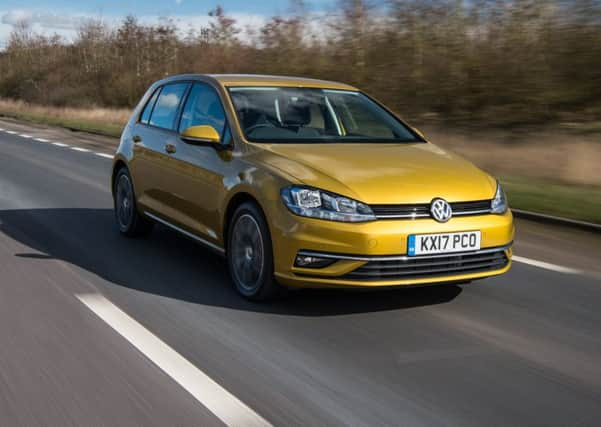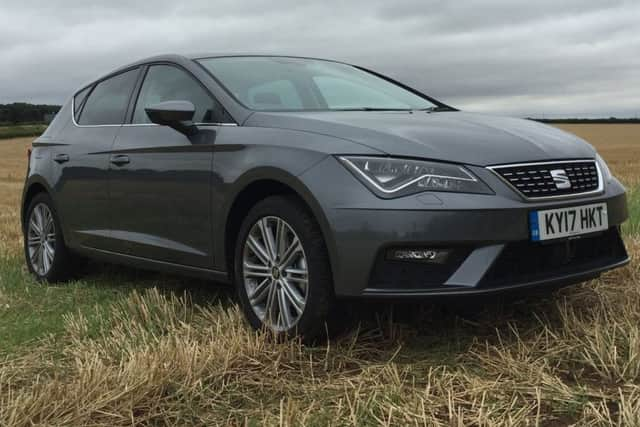Review: Seat Leon and VW Golf SE


There was a 20 per cent drop in national sales of new diesels in July, compared with a 3 per cent drop for petrol. Alternative fuel cars, including electric, are the only growing sector, up 65 per cent in July, taking the seven-month sales to 67,528. Diesels sold 682,538 and nearly 814,000 buyers chose petrol engines. Figures used to be level pegging.
Contrasting fortunes for the big German importers, too. Mercedes-Benz and Porsche are doing best, BMW and Audi less well. The French are stumbling, with the most marked declines at Citroën and its DS offshoot and their parent Peugeot, despite boasting the European car of the year in the 2008.
Advertisement
Hide AdAdvertisement
Hide AdThe star gainer in the Volkswagen Group is Spain’s Seat, ahead 21 per cent. This week I try its Leon, bearing the name of that fabulous city in northwest Spain. The model dates from the late 1990s and is based on the VW Golf. Leon is made at Martorell, Barcelona, which also makes the Ibiza and the Audi Q3 and Seat’s new compact SUV, the Arona.


Leon had a mid-life revamp this year for the three-door SC, the ST estate and the five-door family hatch, reviewed here. Its suspension is set firmer than the Golf and this makes it feel sportier, with a slight offset in comfort. There is a choice of VW Group petrol and diesel engines. However, the new 1.5 petrol engine is not yet offered in the Leon.
The Leon exterior facelift was subtle, so park it next to last year’s Leon and you’ll hunt to spot the changes. Inside, all bar the entry model get a large touchscreen and “infotainment” upgrade. My demo car had a 148bhp 1.4 petrol turbo engine with a seven-speed twin clutch DSG automatic gearbox, in Xcellence Technology trim. Very nice, too. This brings scripted stainless steel door sill covers, plus keyless entry and ignition, auto wipers, auto lights, auto dimming mirror, “comfort” suspension with 17-inch alloys carrying 225/45 Bridgestone Turanza tyres. What it doesn’t have is easy turn-knob adjustment of the navigation map scale.
The combination of the petrol engine and gearbox seemed ideal. When cruising the engine can run on two cylinders to save fuel. The handling was sporting without being harsh. The fuel economy ranged from the low to the high 40s, making the “official” 57.6mpg not too fanciful. The 0-62mph time of eight seconds marks it as a brisk mover, while the CO2 rating of 115g gives affordable road tax. Being petrol, there shouldn’t be an emissions backlash in its lifetime.
The cost is £23,350 plus £575 for the monsoon grey metallic paint.


Seat, Skoda, Volkswagen and Audi now use the same basic structures. So, a Polo is a Fabia is an Ibiza (and an A1), while a Golf is a Leon (and an A3) but not quite an Octavia – which is larger. Seat’s Ateca is based on VW’s Tiguan and made in the same Czech factory as the Skoda Karoq, which replaces the loved Yeti. Coming from Seat is a larger Kodiaq-sized SUV, to be revealed next month.
Volkswagen is bringing us a longer Tiguan called Allspace (Kodiaq-sized) in the booming SUV/crossover markets. Also on the way, the Arteon, from £34,000 next month, a svelte five-door fastback which is positioned above the Passat in allure and technology. Polo and Golf have been revised this year and we’ve had teasers for a two-door, Golf-sized sports SUV called T-Roc.
The latest Golf updates the Mk 7 version with mild visual changes outside and infotainment advances on the dashboard. It also has the new 1.5 petrol engine not yet available in its siblings. Even entry models get an 8-inch colour screen and my SE Nav demo had turn-knob mapping adjustment.
Advertisement
Hide AdAdvertisement
Hide AdThe manipulation of diesel engine emissions around the world has dulled the VW shield and its bank account. On top of that, consumer confidence is being affected by uncertainty over both Brexit and government clean air plans. Mike Hawes, chief executive of the Society of Motor Manufacturers and Traders, adds: “It is important to remember that there are no plans to charge drivers using the latest Euro 6 models and no proposed bans for conventional petrol and diesel vehicles for some 23 years.”
If you are not doing diesel there is also the choice of a petrol/electric hybrid Golf and a new all-electric version claimed to manage 180 miles per charge. The nation’s love for the Golf has made it third best-seller this year and second in July, only 15 sales behind the Focus.
My Golf SE had the DSG automatic gearbox and the charming one-litre, three-cylinder, six-valve petrol turbo engine, measured at 108.5bhp and a gutsy 148lb ft torque – enough to hammer the drive train rather crudely leaving a T junction. (Seat offers a 113.4bhp version in the Leon.)
It is rated at 60.3mpg and 107g. The 0-62mph time is a respectable 9.9 seconds. Its price of £20,880 brings radar distance monitoring speed control, smartphone links, DAB etc. Visible extras were this season’s new shade, turmeric metallic (£570), and 17-inch wheels with wider and shallower tyres (£615) instead of the standard 16s.
The paint drew attention, but the taller wheels made the ride a shade harder. The economy was on the friendly side, with over 50mpg in local motoring and 48mpg on a topsy turvy tour round the Lakeland of Peter Rabbit and Swallows And Amazons.
Verdict: Leon trails Golf in sales and social appeal. Each has its followers.